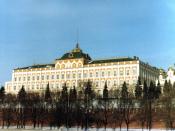The progress made by the USSR in the twenty years between 1945 and 1965 has been seen by some as proof that a state based on a centrally planned economy can be effective. However there is another side to the argument, which claims that the Soviet Union during this period shows the superiority of the market based economy favoured by western European countries and the USA. To answer the above question it is necessary to first define a centrally planned economy, then to look at both the successes and shortcomings of the Soviet Union during this time. Also, comparison between the USSR and similar countries as well as their main rival superpower, the USA, will help a conclusion to be reached.
A centrally planned economy "is one in which all economic decisions are taken by a central authority" where private ownership is minimal. This is opposed to the western market economy, which encourages private ownership and where state control is far less than the socialist system.
Benefits of the centrally planned economy include high employment, a more equal distribution of national income and high growth rates due to resources being directed into investment, while disadvantages include a reduction in individuals' ability to make decisions, fewer incentives to individuals and due to individuals being able to spend as they wish, shortages and surplus of supplies arising . However, these advantages and shortcomings are theoretical and it is vitally important to look at the actual successes and failures of the USSR between 1945 and 1965.
Of the successes made by the Soviet Union in this twenty year period, perhaps the most well known is their victory in the race to put a man in space. When Yuri Gagarin orbited the earth April 12th 1961 , the event heavily added to...


